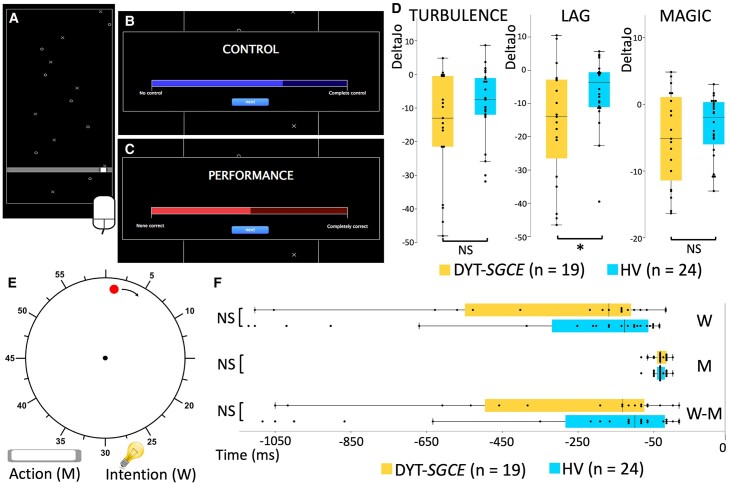Figure 1.
Explicit and implicit agency tasks. (A) Explicit agency task: subjects were seated facing a computer screen and used their dominant hand to move the mouse, which drove a squared cursor along a horizontal line drawn at the bottom of the screen. Throughout all trial conditions, targets (X) and distractors (O) appeared at the top of the screen and moved down the screen at a consistent speed. Subjects were instructed to move the cursor to intercept the targets and to avoid the distractors when they arrived on the horizontal line. They were notified of a target (‘beep’) or a distractor (‘boop’) by specific audio feedback. Conditions were presented in 15-s blocks, repeated six times in a random order (6 × 4 blocks in total). The experiment included a training session of 1 or 2 controls blocks upon subject request. (B, C) Judgement phase of the explicit agency task. The participant clicked on the blue bar to report his or her judgement of control over the cursor’s movement (B). Likewise, the participant clicked on the red bar to report his or her judgement of goodness of performance (C). (D) The summary agency score for each experimental condition in the explicit agency task were compared between groups using ANOVA (19 patients with DYT-SGCE and 24 healthy volunteers). Groups differed in the Lag condition (F(1,42) = 26.04, P = 0.004). (E) Implicit agency task. Subjects were seated facing a computer screen, kept their hands on the keyboard and watched a 20-cm diameter clock on the screen. A dot appeared in random position on the circular border of the clock and travelled the circumference of the clock in a 6-s revolution time. In each trial, subjects were asked to press the space bar, resulting in stop of the dot which then disappeared. A marker appeared at a random position on the border of the clock, which could be moved around the clock with the left and right arrows. Participants returned the marker to its position when they had decided to press (‘intention’ condition) or pressed (‘action’ condition) the button. ‘M’ was a judgment (expressed in milliseconds) of the participants’ estimated marker position when they had pressed the spacebar compared to the real stop position of the dot. ‘W’ was a judgment (expressed in milliseconds) of the participants’ estimated marker position when they had decided to press the spacebar compared to the real stop position of the dot. ‘W-M’ is the difference (expressed in milliseconds) between the two. (F) Judgments for the ‘Action’ (judgment ‘M’) and ‘Intention’ (judgment ‘W’) conditions and overall judgment ‘W-M’ in the implicit agency task in milliseconds (ms) were compared between groups using ANOVA. DYT-SGCE , myoclonus dystonia; HV, healthy volunteers; DeltaJo, summary agency score; M, action block; W, intention block. *Significant results (P < 0.05). NS, non-significant results.

